---------- Forwarded message ----------
From: Bobrowicz, Jakub <jakub.bobrowicz@hanovernorwichschools.org>
Date: Thu, May 30, 2013 at 11:57 AM
Subject: Aves
To: thermanson1.vertabrates@blogger.com
From: Bobrowicz, Jakub <jakub.bobrowicz@hanovernorwichschools.org>
Date: Thu, May 30, 2013 at 11:57 AM
Subject: Aves
To: thermanson1.vertabrates@blogger.com
Aves are feathered, winged, endothermic, bipedal vertebrates, more commonly known as birds. Most are able to fly, and all lay yolked, hard shelled eggs, and have a strong, light skeleton.















































